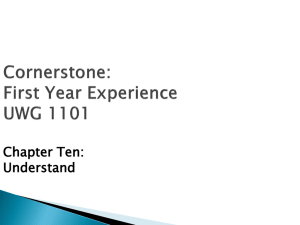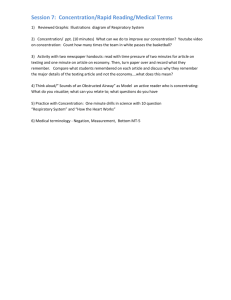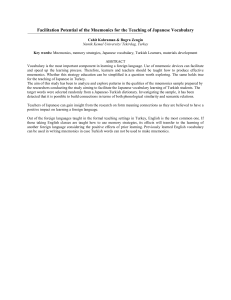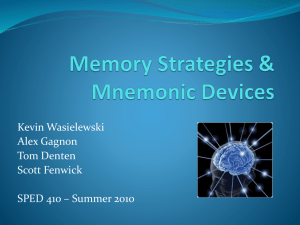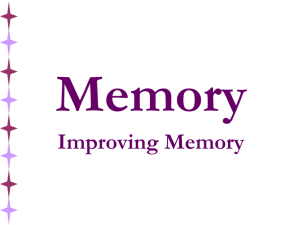Mnemonics and Strategies for Improving Memory
advertisement
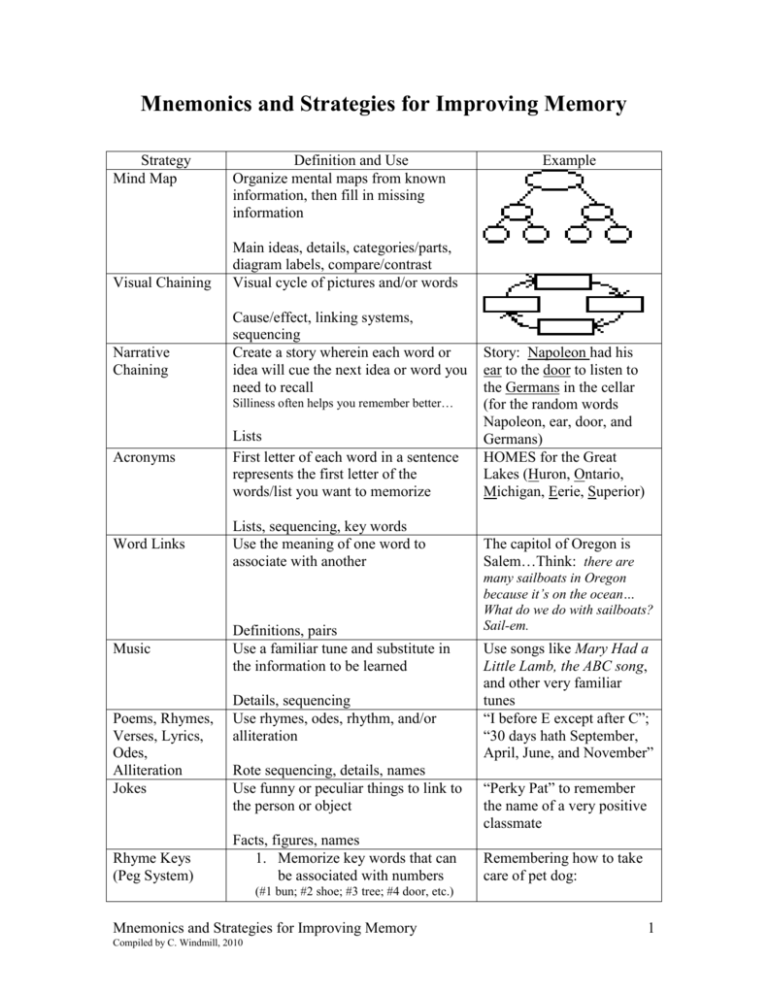
Mnemonics and Strategies for Improving Memory Strategy Mind Map Visual Chaining Narrative Chaining Definition and Use Organize mental maps from known information, then fill in missing information Example Main ideas, details, categories/parts, diagram labels, compare/contrast Visual cycle of pictures and/or words Cause/effect, linking systems, sequencing Create a story wherein each word or idea will cue the next idea or word you need to recall Acronyms Lists First letter of each word in a sentence represents the first letter of the words/list you want to memorize Story: Napoleon had his ear to the door to listen to the Germans in the cellar (for the random words Napoleon, ear, door, and Germans) HOMES for the Great Lakes (Huron, Ontario, Michigan, Eerie, Superior) Word Links Lists, sequencing, key words Use the meaning of one word to associate with another The capitol of Oregon is Salem…Think: there are Silliness often helps you remember better… Music Poems, Rhymes, Verses, Lyrics, Odes, Alliteration Jokes Rhyme Keys (Peg System) Definitions, pairs Use a familiar tune and substitute in the information to be learned Details, sequencing Use rhymes, odes, rhythm, and/or alliteration Rote sequencing, details, names Use funny or peculiar things to link to the person or object Facts, figures, names 1. Memorize key words that can be associated with numbers many sailboats in Oregon because it’s on the ocean… What do we do with sailboats? Sail-em. Use songs like Mary Had a Little Lamb, the ABC song, and other very familiar tunes “I before E except after C”; “30 days hath September, April, June, and November” “Perky Pat” to remember the name of a very positive classmate Remembering how to take care of pet dog: (#1 bun; #2 shoe; #3 tree; #4 door, etc.) Mnemonics and Strategies for Improving Memory Compiled by C. Windmill, 2010 1 2. Create an image of the items you need to remember with the key words (Rhyme Keys, Peg System) Take-a-Trip (Method of Loci) Lists, procedures Visualize familiar objects around a room and attach some information or word to each object Acrostics Lists Make up a sentence using the first letter of each word Picture Objects (Visualization) Hookups Keyword Image Name Make a Tape Write It! Bun + feed dog Shoe + walk dog Tree + let dog outside to pee Door + let dog back inside Every Good Boy Deserves Fudge for the treble clef line notes (E, G, B, D, F) Sequencing, lists, key words Use a positive and pleasant familiar object and associate information around it; vivid, colourful, and 3D images work best Picture your finger. To learn prepositions of place, visualize an object in relation to your finger. Lists, details Use one word or series of letters and chunk up the information beginning with the same letter N New Brunswick Nunavut Nova Scotia Details, categories/parts, lists Use an English word that sounds like a foreign one. Imagine an image that involves the key word with the English meaning of the foreign word Pato in Spanish means duck. Imagine patting a duck. Vocabulary in a foreign language Invent a relationship between the name Shirley Temple: her hair is and a physical characteristic of the curly (rhymes with Shirley); person Imagine she has a curl near her temple. Names and faces Tape the information to be learned Play the information several times over several days. Vocabulary, foreign languages, Play it just before going to spelling, lists, sequences, and others sleep at night. Write it repeatedly and say it aloud as Write it just before going to you write sleep. Details, categories/parts, lists, vocabulary, foreign languages, Mnemonics and Strategies for Improving Memory Compiled by C. Windmill, 2010 2 (Write It!) spelling, sequences, and others Get Moving! Use your mnemonic devices and strategies while your body is in motion (walking, jogging, taking the dog out for a run, using a stationary bike, chewing gum, etc.) Rehearse the information you’ve learned while you’re moving; works especially well for kinaesthetic learners HOW TO REMEMBER THE FOLLOWING KINDS OF INFORMATION… Strategy Numbers Poetry Sayings Mental Pictures (Visualization) Create an Experience Definition and Uses Write the numbers to be remembered; notice a special sequence and associate it with some familiar date (like a birthday) Break the poetry down into small, meaningful sections (chunk the info) Link information with a famous saying and substitute words Visualize how you see or expect to see a total picture Mentally and visually create/recall an experience and link information to be learned with what you do Mnemonics and Strategies for Improving Memory Compiled by C. Windmill, 2010 Example 236-4408 (2 x 3 = 6; 4+4=8) Make it into a story. Practice the meter and rhyme A penny saved is… A stitch in time… Close your eyes and visualize an X-ray view of the skeleton from the head down (skeletal labeling) Imagine yourself cooking a favourite meal or building something; plug information to be learned into each step 3 Note-Taking Mnemonics The way notes are organized can inhibit or promote learning and recall. Strategy Flash note cards Use/Example Organize main ideas and relevant details Outlines Format main ideas into possible test questions; put questions on one side of card and answer on the other; test self or others Separate main ideas from details Ex: PIAGET’S THEORY A. Four stages 1. Sensorimotor 2. Preoperational…. Draw a vertical line about 3 inches from left margin. Place main ideas or questions to the left of the line and details or answers to the right of the line Cornell System MIRRORS A structure for teaching mnemonics to students Model the strategy and explain how to carry it out; Inform students when and how to use it; Remind them to use it; Repeat the strategy for practice; Outline why the strategy is useful; Reassess students’ performance when using the strategy; Stress the generalization of the strategy to other activities, content areas, settings, and over time http://www.allkindsofminds.org/learningBaseSubSkill.aspx?Ibssid=77&mode=print, accessed March 9, 2010 Mnemonics and Strategies for Improving Memory Compiled by C. Windmill, 2010 4
